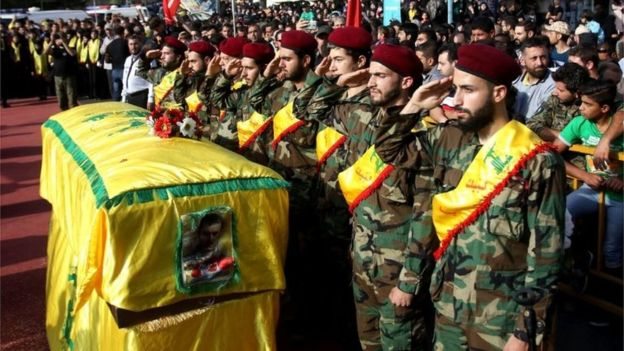Nadav Pollak and Hanin Ghaddar
How has Hezbollah avoided a catastrophic quagmire in Syria and even exploited its campaign there to enhance its military capabilities? Two experts chart the group’s evolution and its future threats to Lebanon, Israel, and regional order.
On August 11, Nadav Pollak and Hanin Ghaddar addressed a Washington Institute Policy Forum marking the publication of the new study “The Transformation of Hezbollah by Its Involvement in Syria.” Pollak, the paper’s author and a former Diane and Guilford Glazer Foundation Fellow at the Institute, currently works as a counterterrorism analyst at the Anti-Defamation League. Ghaddar is the Institute’s inaugural Friedmann Visiting Fellow and former managing editor of Lebanon’s NOW news website. The following is a rapporteur’s summary of their remarks.
NADAV POLLAK
Despite extensive reporting on Hezbollah’s involvement in Syria, little attention has been paid to the experience the militia has gained there or the consequences it faces back home in Lebanon. The Hezbollah contingent in Syria (often referred to as “Hezbollah’s Eastern Command” by Israeli analysts) deploys between 5,000 and 8,000 fighters at any given time, including Special Forces (Katibat Radwan), standing forces from all units, part-time fighters (taabia), and new recruits who have undergone a fast-tracked combat training period of 60-90 days — an unprecedented development. Still, Hezbollah fighters are not cannon fodder; they often lead battles and command Syrian and Iranian militias in combat.
This heavy involvement in Syria seems to be influencing the group’s overall approach to military planning and execution. According to a study written by an Israel Defense Forces officer in 2014, Hezbollah would likely employ a more offensive fighting strategy in any future war against Israel, with the objective of shortening the conflict’s length. And regardless of whether the group actually implements such a strategy, there is no doubt that some of its military capabilities have improved significantly. It has learned how to use its drones more effectively, take better advantage of its short-range rockets, and execute complex offensive operations.
At the same time, the Syria war has decreased Hezbollah’s popularity among the Shiite community in Lebanon, particularly as financial constraints lead to cuts in salaries and social services. In response, the group has framed the conflict as a war of necessity against Sunni extremism, with leader Hassan Nasrallah preying on widespread sectarian fears by issuing frequent reminders about the need to defend against the Islamic State and al-Qaeda affiliate Jabhat al-Nusra. Furthermore, Hezbollah’s continued funding of its support base, combined with the lack of alternatives from state institutions or other organizations, has ensured continued public support despite the dip in popularity.
Regarding Hezbollah’s future, three points are important to remember: (1) the group will remain committed to fighting in Syria alongside Iran and the Assad regime, (2) the war has solidified its position within the “axis of resistance,” and (3) improvements in its capabilities will likely trickle down to other militias and terrorist organizations in the Middle East. In other words, groups that received training from Hezbollah or monitored its tactics even before the Syria war — such as Shiite militias in Iraq, the Houthis in Yemen, and Palestinian organizations like Hamas and Islamic Jihad — will likely incorporate the organization’s new tactics into their own operations in the coming years.
HANIN GHADDAR
To ensure its survival, Hezbollah has based its activities on three main pillars: (1) establishing an independent economy and social services in Lebanon (e.g., education and housing), (2) emphasizing continual “resistance” tied to the liberation of occupied lands (a concept essentially hijacked from Lebanon’s National Resistance Front of the 1980s), and (3) invoking collective memories of the martyrdom of Ali, the first Shiite Imam, which provides the context for Hezbollah’s political and military role in Lebanon. By cleverly linking these pillars, the group has been able to mobilize Shiites around its banner while also gaining access to state institutions, the economy, and the political establishment.
When Hezbollah began its involvement in Syria, its priorities, strategies, and narrative shifted. First, it devoted much more of its budget to military spending. Although funding for social services continued, more of it was directed to families and institutions linked to Hezbollah’s military infrastructure, as part of an effort to support the troops.
Second, the policy of “resistance” against Israel became secondary as the group shifted its focus to the Syrian conflict. Today, Hezbollah is openly hesitant to start a war with Israel.
Third, the organization has abandoned its rhetoric of “divine victory.” Once considered a force that won quick, decisive victories, Hezbollah is now a force that ships home the bodies of “martyrs” killed while fighting a foreign war. Combat in Syria provides little room for divine victory; casualties and defeats in Aleppo and elsewhere are described as “setbacks.”
Indeed, as Hezbollah becomes more deeply entrenched in Syria, the resistance that once attracted eager volunteers has transformed into a corporate institution of anxious and exhausted fighters. Far from answering a calling, recruits are now signing on for a job in the Syria war, spurred by the monthly salary of $500-1,200 with benefits (though the organization no longer provides compensation to the families of “martyrs”).
Today, many Hezbollah fighters have become disillusioned by the group’s role in the Syrian conflict, by the arrogance and military ineptitude of allied Iranian forces, and by the corruption and weakness of the Syrian army. They also worry that Russia will sell them short if it serves Moscow’s interests in Syria — while Hezbollah is sending more fighters to Syria, Vladimir Putin is making agreements with Turkey and Israel.
Meanwhile, the war has created a stark divide within the Lebanese Shiite community. Now that Hezbollah is increasingly perceived and structured as a regional Shiite militia, many Shiites have found it almost impossible to find work at Sunni institutions in Lebanon and the Gulf countries. Lebanese Shiites in particular have few employment opportunities outside those provided by Hezbollah. In the southern Beirut suburb of Dahiya, for example, most residents would be unemployed if not for the group’s heavy deployment in Syria.
Although the conflict has exhausted Hezbollah fighters, drained the Shiite community socially and financially, and deepened class differences, the sons of senior Hezbollah officials are thriving — a phenomenon that has sparked feelings of disenfranchisement among many Lebanese Shiites. These social divides, as well as the loss of three-fourths of the group’s field commanders since the 2006 war, have increased fatigue among Shiite fighters and civilians. While a new confrontation with Israel would likely rejuvenate Hezbollah’s esprit de corps, the social and financial burdens of fighting a foreign war have taken a significant toll on the organization’s support.

